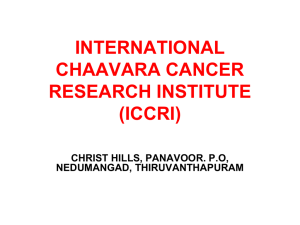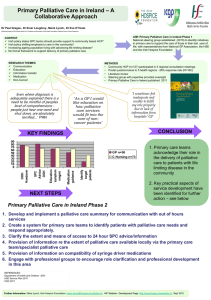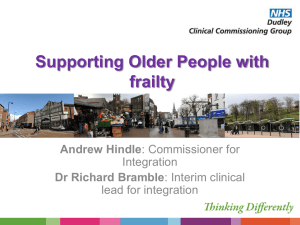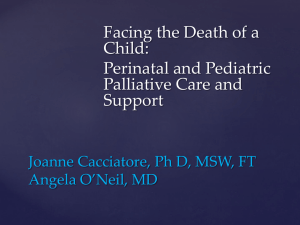Palliative Care and Delivering Bad News - I-TECH
advertisement
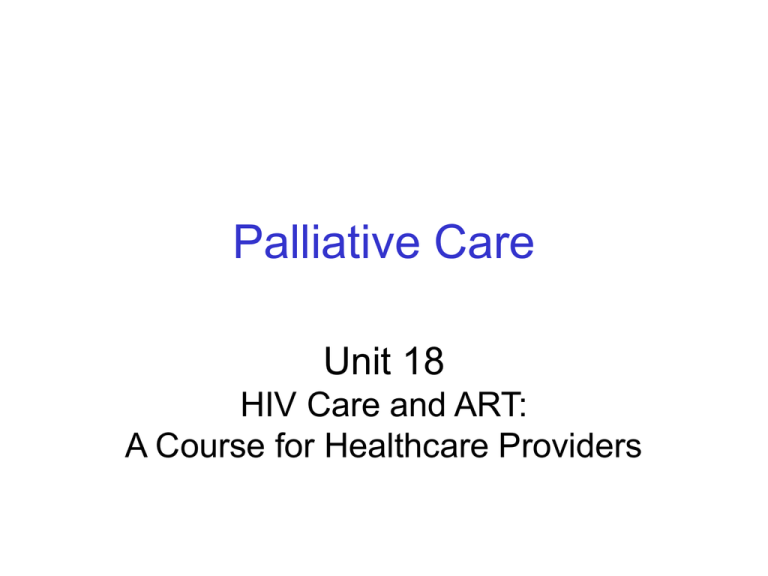
Palliative Care Unit 18 HIV Care and ART: A Course for Healthcare Providers Learning Objectives Define palliative care and its role in the management of HIV Describe palliative care in the African context Assess and manage pain and dyspnea in HIV Communicate bad news and discuss end-of-life care 2 Introductory Case: Yared Yared is a 35 year-old HIV+ gentleman who returns to clinic complaining of nausea and diarrhea. 6 months ago his ART regimen was changed to Nelfinavir, AZT, and ddI because of immunologic treatment failure. The patient has a history of CNS toxoplasmosis and pulmonary TB. He lost his job and started drinking ETOH daily since his wife died in a car accident 1 year ago. 3 Introductory Case: Yared (cont.) Alert and oriented, but appears fatigued and chronically ill T 37.7 HR 110 BP 90 / 70 47 kg (7 kg weight loss since last visit) Pale conjunctivae White plaques on soft palate Normal exam otherwise 4 Introductory Case: Yared (cont.) Volume depletion Nausea & diarrhea Clinical treatment failure (new thrush, wt loss) Pallor Alcohol dependence Unemployment What are his palliative care needs? 5 Principles of Palliative Care Interventions that improve the quality of life for patients and their families Prevention and relief of suffering pain and other physical problems psychosocial and spiritual issues An integral part of a comprehensive care and support framework 6 Principles of Palliative Care In the framework of a continuum of care from the time the incurable disease is diagnosed until the end of life Regards dying as a normal process and affirms life Offers support to help the patient and family cope during the patient’s illness and in the bereavement period 7 Pre-HAART Palliative Care Model Therapies to modify disease (curative, restorative intent) Diagnosis Hospice 6m Death Bereavement Care 8 The Role of Palliative Care in HAART Era Therapies to modify disease (curative, restorative intent) Life Closure Actively Dying Diagnosis 6m Death Palliative Care: interventions intended to Bereavement relieve suffering and improve quality of life 9 Care Palliative Care and ART Antiretroviral therapy does not avert the need for palliative care 40–50% of patients experience virological failure 40% of patients have adverse reactions HIV-related cancers still occur Psychological and spiritual needs persist 10 Role of Palliative Care in HIV Treatment of antiretroviral side effects Management of HIV complications Relief of psychosocial challenges Improved ART adherence Reduction of drug resistance in the individual and community Preparation for end-of-life 11 Introductory Case: Yared (cont.) Nausea Diarrhea Fatigue Substance dependence Unemployment Lack of social support 12 Return to Case Study Yared returns to the clinic 1 month later His diarrhea and nausea have improved with interventions offered at the last visit. He is still fatigued, however, and continues to use ETOH. He is now living with his uncle 500 km away from clinic. 13 Palliative Care in Africa Palliative care models for developed countries may not work in Africa Feasibility ? Accessibility ? Sustainability ? Cultural diversity ? 14 Challenges to Palliative Care in Africa Late disease presentation Inadequate diagnostic facilities and assessment skills Poor availability of chemotherapy and radiotherapy Absence of opioids Regulatory and pricing obstacles Ignorance and false beliefs 15 Cultural Variation and Preferences A “good death” in Africa varies culturally and historically Bearing bad news could be seen as the cause of a terminal illness Labeling patients as “terminally ill” may have harmful consequences Isolation Denied access to care Traditions need to dictate appropriate models of care 16 Palliative Care Needs in Africa Hospice care (home and hospice center) Pain and symptom control Financial support Emotional and spiritual support Food and shelter Legal help and school fees 17 Models in Africa Home-based care has been the most common service model in Africa Limitations of home-care models Inadequately trained care givers Lack access to essential drugs Limited access for patients in inaccessible geographical areas Stigma 18 WHO Palliative Care Project WHO “community health approach to palliative care for HIV/AIDS and cancer patients in Africa project.” 2001 Botswana, Ethiopia, Uganda, Tanzania, and Zimbabwe Objective Improve the quality of life of patients and their families in African countries Develop home based palliative care models 19 End of Life Experience in Ethiopia 86 adults surveyed Families members of a person bed-ridden with AIDS The most common problems identified: • Pain associated with the illness (76%) • Vomiting, diarrhea, and appetite loss (30%) • Cost of and lack of drugs 20 End of Life Experience in Ethiopia (2) Patient needs were not met in most cases Relief of pain Relief of symptoms Burden on family Education interruption Financial constraints Emotional (anxiety, fear, sadness) Physical 21 The Role of Stigma in Ethiopia Physician reluctance to pass bad news to patients on any health matter, especially AIDS Fear of discrimination often prevents many Ethiopians from seeking treatment for AIDS Many people with AIDS have been evicted from their homes by their families and rejected by their friends and colleagues Infected children are often orphaned or abandoned 22 Direction of Palliative Care in Africa Understanding of the capacity and needs of the community Innovation within a framework Trend towards home-based care (e.g. Ethiopia) Integrated approach with strong referral links Addresses need at all stages of disease Provision of simple protocols The WHO Integrated Management of Adolescent Illness (IMAI) manual Advocacy 23 Introductory Case: Yared (cont.) Yared returns to the clinic 4 months later He is very fatigued and has developed burning lower extremity pain. 24 Advanced HIV: A Spectrum of Symptoms Pain Diarrhea, nausea, vomiting Fever Dyspnea, cough Fatigue Orthopnea, PND Skin disorders Confusion Depression, anxiety, fatigue, fear 25 Pain The symptom most feared when patients contemplate death Usually a manifestation of physical distress May be exacerbated by anxiety, fear, depression Ability to tolerate and cope with pain varies drastically between patients 26 Pain Syndromes in HIV Abdominal pain Peripheral neuropathy Oropharyngeal pain Headache pain Post-herpetic neuralgia Musculoskeletal pain 27 Peripheral Neuropathies Among the most common causes of pain in HIV The neuropathies associated with HIV can be classified as Primary HIV-associated Secondary diseases caused by • Neurotoxic substances • Opportunistic infections Grouped by Timing in relation to onset of HIV infection Clinical and diagnostic features 28 Distal Symmetrical Sensory Polyneuropathy (DSSP) Most frequent neurological complication associated with HIV infection > 1/3 of HIV-infected patients Pathophysiology unclear Course: Slowly progressive sensory features Location: feet, lower extremity, sometimes hands; symmetrical distribution 29 Clinical feature of DSSP Symptoms Pain Tingling Numbness Signs Depressed or absent ankle reflexes Elevated vibration threshold at toes and ankles Decreased sensitivity to pain and temperature in a stocking distribution 30 NRTI associated DSSP Thought to be secondary to mitochondrial toxicity from ddI, d4T or ddC Clinically indistinguishable from HIV-related DSSP Temporal relationship to NRTI drug use Up to 30% of patients affected; after 3-6 mo of use May be permanent Increase risk associated with advanced HIV disease, alcoholism, diabetes, vitamin B12 or thiamine deficiency, and neurotoxic drugs (e.g. INH) 31 NRTI associated DSSP (2) Early recognition is critical NRTI dosing May be dose-reduced May be stopped and switched to an alternate nontoxic antiretroviral agent Symptomatic relief may begin to be noted approximately 4 weeks after discontinuation of the neurotoxic antiretroviral In some patients, symptoms may persist, most likely because of coexistent HIV DSSP 32 Assessment of Neuropathic Pain History: onset, duration, character, and severity (scale 1-10) Physical examination: Pain and temp (diminished sensation in DSSP) Ankle reflexes (absent or depressed in DSSP) Vibratory (elevated thresholds at the toes in DSSP) Proprioception and muscle strength (preserved except in severe cases of DSSP) 33 Pharmacologic Management of Neuropathic Pain Mild pain: Non-opioid analgesics Ibuprofen 600-800mg orally three times per day Paracetamol (Acetaminophen) Moderate-to-severe pain: opioid analgesic combinations Paracetamol plus codeine Adjuvant analgesics • TCAs (Amitriptyline) • Anti-epileptics (Lamotrigine and Gabapentin) Severe pain: opioid analgesic Morphine 34 Return to Case Study Yared returns to clinic 2 weeks later with continued pain despite Dose reduction in ddI (200 bid ->125 bid) Stopping ETOH Taking Ibuprofen 600mg bid. Physical examination is unchanged 35 WHO 3-step Analgesics Ladder 3 severe ■ Morphine 2 moderate ■ Hydromorphone ■ A/Codeine ■ Methadone ■ A/Hydrocodone ■ Levorphanol ■ ASA ■ A/Oxycodone ■ Fentanyl ■ Acetaminophen ■ A/Dihydrocodeine ■ Oxycodone ■ NSAIDs ■ ± Adjuvants ■ ± Adjuvants 1 mild ■ ± Adjuvants 36 Return to Case Study Yared returns 2 months later He is tachypneic, cyanotic, delirious, and unable to stand. He says to you “I can’t breath”. 37 Dyspnea A subjective awareness of difficulty or distress associated with breathing Mechanisms are not well understood Often ignored by health professionals The patient's report is the best indicator of dyspnea Not respiratory rate and oxygenation status Often takes a chronic course of respiratory decline Punctuated by episodes of acute shortness of breath and increased anxiety 38 Causes of Dyspnea in HIV Opportunistic infections Pulmonary malignancies Pneumothorax Asthma Bronchiectasis Pulmonary embolism Severe anemia Congestive heart failure Debilitation / severe wasting 39 Assessment of Dyspnea History Onset, duration, PCP-prophylaxis Physical exam Vitals, Pulmonary, Cardiac, Extremities, etc Diagnostic testing CXR, CBC, Chemistry Prompt diagnosis Ensure best chance of curative treatment 40 Return to Case Study Onset of dyspnea was gradual, and associated with dry cough and fever. He stopped taking Bactrim one month ago T 38.5 HR 110 BP 98 / 70 RR 35 Pale, cyanotic, fatigued Cardiac and lung exam were normal No lower extremity edema Laboratory: Hgb 5 gm/dl, MCV 104, Creatinine 1.1. 41 Introductory Case: Yared (cont.) 42 © Slice of Life and Suzanne S. Stensaas Introductory Case: Yared (cont.) Yared was admitted to the hospital and started on high dose Co-trimoxazole plus steroids for treatment of PCP He was also provided a blood transfusion. 43 Nonpharmacologic Treatment of Dyspnea Position patient for comfort Prop patient forward using pillows May allow better lung expansion / gas exchange Provide cool circulating air Encourage presence of family and caregivers Consider pursed-lip breathing Promote soothing activities, such as prayer or listening to relaxing music 44 Oxygen Therapy Titrated to comfort is recommended for terminally-ill, hypoxemic, and dyspneic patients Role in treating patients who are not hypoxemic is less clear Many patients and families believe that oxygen can alleviate shortness of breath If it does no harm, oxygen administration may confer a psychological benefit 45 Pharmacologic Management of Dyspnea Opioids - the primary modality Mechanism of action is not clearly understood Start low dose (5 to 10 mg PO morphine or 2 to 4 mg IV or SC morphine) Start early in course of dyspnea • help reduce the effects of respiratory depression • allows for rapid titration to levels that can comfort the patient and reduce anxiety 46 Pharmacological Management of Dyspnea Anxiolytics Should be considered as a second-line intervention Used when a "true” anxiety (psychological rather than physiologic in origin) is perceived Disease specific treatment Bronchodilators Diuretics Steroid Antibiotics 47 Cough Violent expiration of air through the glottis Thought to result from irritation and inflammation of sensory receptors in the tracheobronchial tree Usually related to Increased mucus production Aspiration of mucus Gastric contents 48 Cause of Cough in HIV Inflammatory processes caused by infections Tuberculosis Bacterial / fungal pneumonia Bronchial lesions Lung parenchymal disease 49 Management of Cough Avoid stimuli that may induce coughing smoke, cold air, exercise Elevate head of bed (reduce gastroesophageal reflux) Bronchodilators Corticosteroids Cough suppressant (when no therapeutic reason to stimulate cough) Opioid based medicine 50 Delirium An acute confusional state Disturbances of level of consciousness Attention Thinking Perception Memory Psychomotor behavior Progresses rapidly over hours or days Early symptoms are often nonspecific irritability disturbances in the sleep-wake cycle 51 Cause of Delirium in HIV Infection Metabolic Drugs Endocrine Inflammation Vascular Malignancy 52 Management of Delirium Assess and treat underlying cause Create quiet, familiar, comfortable environment If persistent Antipsychotics (Haloperidol) Anxiolytics (Diazepam) – use with caution; may worsen confusion 53 Introductory Case: Yared (cont.) Despite 10 days of appropriate therapy for PCP, the patient’s condition continues to deteriorate. Additional measures have been taken to manage the patient’s dyspnea, cough, and delirium. AB’s uncle and sister arrive later to the hospital. The family wants to know his status and prognosis. 54 Bad News Physicians are continuously faced with the challenge of telling patients and their families bad news 55 Clinical Outcomes How bad news is discussed has implications patient's comprehension of information satisfaction with medical care level of hopefulness subsequent psychological adjustment Delivering unfavorable medical information does not necessarily cause psychological harm Patients desire accurate information to assist them in making important quality-of-life decisions 56 Response to Bad News When patients are given bad news, they have a wide variety of reactions. There is no single reaction to expect. Possible reactions: Shock Fright Accept Sadness Not worried 57 Discussing Death: Cultural Perspectives Some cultures believe that discussion of death can hasten it African-Americans Native-Americans Immigrants from China, Korea, Mexico Ethiopians? Need to explore individual perspectives 58 Barriers to Delivering Bad News People who deliver bad news experience strong emotions MD reluctance to deliver bad news Anxiety Burden of responsibility for the news Fear of negative evaluation Fear of destroying hope Inadequacy dealing with the patient's emotions 59 Patient and Clinician Stress Related to Bad News Clinician Patient Stress Encounter Time 60 A Recommended Protocol for Giving Bad News (SPIKES) Set up the interview: mental and physical preparation Perception: assess what the patient knows about the medical situation Invitation: ask how much they want to know Knowledge: give the medical facts Emotion: respond to patients emotions Strategy and summary: negotiate a concrete follow-up step 61 STEP 1: Setting up the Interview Mental rehearsal Anticipate difficult emotions / questions Review strategy / importance of giving information Select appropriate setting Privacy Involve significant others Sit down Initiate connection Manage time constraints 62 STEP 2: Perception “Before you tell, ask” Use open ended questions “What is your understanding of your medical situation?” “What have you been told about your medical condition?” Correct misinformation Tailor bad news to patients understanding Uncover forms of illness denial 63 STEP 3: Invitation Majority of patients want full information (US & Europe) BUT some do not “How would you like me to give the information about the tests?” “Would you like me to give all the information?” 64 STEP 4: Knowledge Warn the patient that bad news is coming “I have some bad news about the results of your blood test.” Use language at the level of comprehension and vocabulary of the patient Use non-technical terminology Avoid excessive bluntness Assess patient’s understanding frequently “Did you understand that? Did that make sense to you?” 65 STEP 5: Emotion Observe Identify Connect cause Communicate understanding Empathize “I know that this isn't what you wanted to hear” I wish the news were better” Reduce the patient's isolation Validate patient's feelings 66 STEP 6: Strategy Develop a clear follow-up plan Address patient goals Discuss management options when patient is ready Share responsibility for decision-making 67 End-of-Life Discussion Utilize SPIKES principles Elicit patient/family’s understanding and values Use language appropriate to the patient Align patient and clinician views Use repetition to show you are listening Acknowledge emotions, difficulty, fears Use reflection to show empathy Tolerate silences 68 Key Points Palliative care is integral to HIV care from the time of diagnosis Palliative care faces unique challenges in Africa and must be culturally sensitive Management of pain and dyspnea includes both pharmacological and non-pharmacological methods Pain is common in HIV and can be managed according to WHO pain ladder Delivering bad news and talking about death is part of effective palliative care 69 Key Points Delivering Bad News Giving bad news and talking about death is a fundamental communication skill for doctors Exploring individual and cultural beliefs is important in adapting the bad news communication to each patient How bad news is delivered can affect how patients adjust to their illness 70

